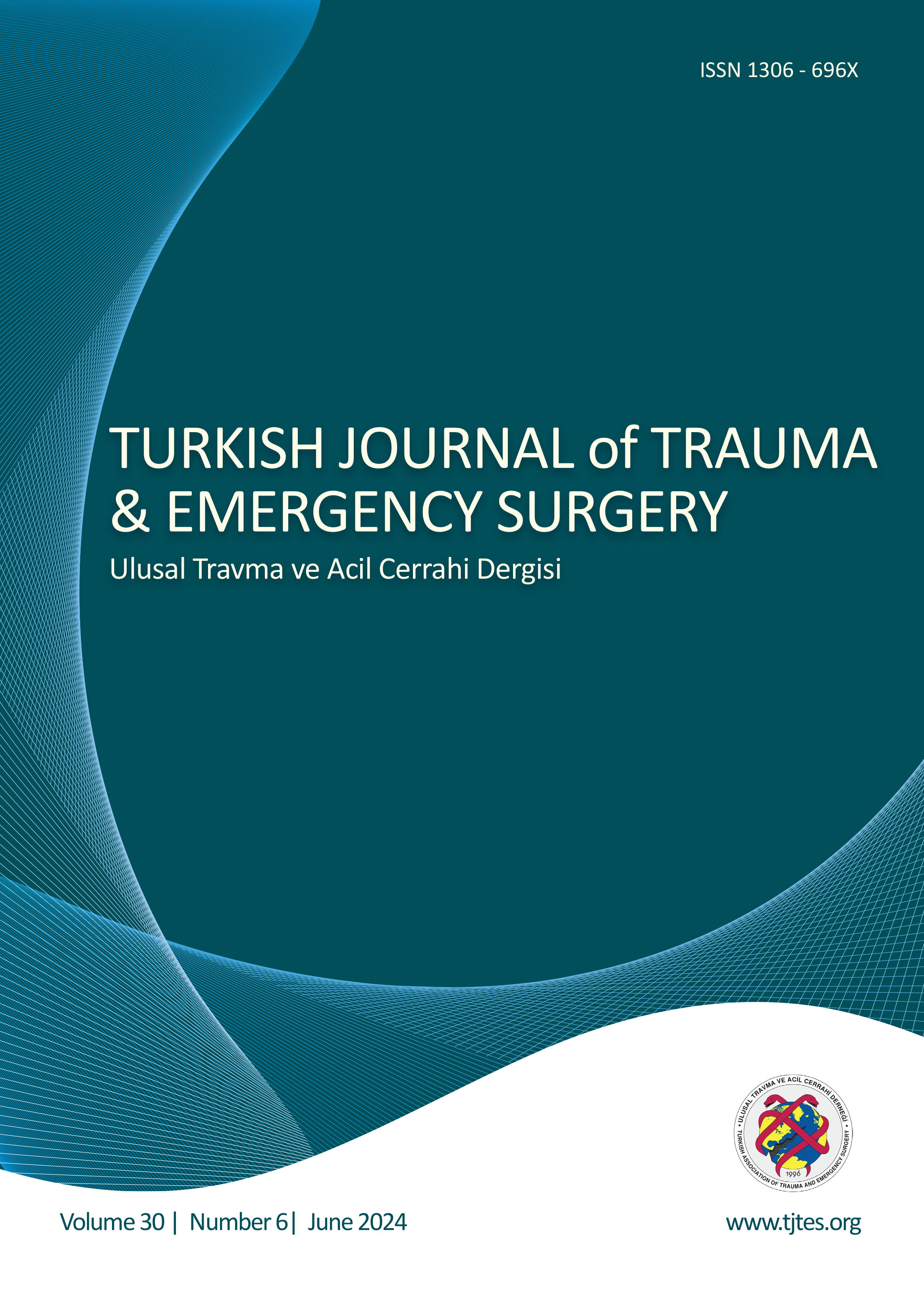Quick Search
The role of trauma scoring systems and serum lactate level in predicting prognosis in thoracic trauma
Eray Çınar1, Eren Usul2, Erdal Demirtaş3, Anıl Gökçe11Department of Thoracic Surgery, Ankara City Hospital, Ankara-Turkey2Department of Emergency Medicine, Dışkapı Yıldırım Beyazıt Training and Research Hospital, Ankara-Turkey
3Department of Emergency Medicine, Dokuz Eylül Universty Faculty of Medicine, İzmir-Turkey
BACKGROUND: Chest trauma constitutes 10% of admissions due to trauma and causes 2550% of trauma-related deaths. It is important to evaluate the level of thoracic trauma in patients accurately and early, start the correct treatment, predict the need for intensive care and mortality, and prevent complications that may develop. In this study, the predictive efficiency of the serum lactate level, shock index, and scoring systems regarding the prognosis in patients with major thoracic trauma were compared.
METHODS: The files of the 683 patients who applied to the emergency department of our hospital due to trauma, between 2014 and 2020, were analyzed retrospectively. Patients with isolated thoracic trauma were included in the study.
RESULTS: A total of 683 patients were included in the study. Of the patients, 34 (5%) were in the non-survivor group and 649 (95%) were in the survivor group. There was no statistically significant difference between the systolic blood pressure, diastolic blood pressure, pulse rate, respiratory rate, or shock index in either group (p>0.05). The Glasgow Come Scale (GCS) score in the non-survivor group was significantly lower than that in the survivor group (p=0.000). The lactate level, revised trauma score (RTS), injury severity score (ISS), and New ISS (NISS) in the non-survivor group were significantly higher than those in the survivor group. A significant difference was found in terms of age, lactate level, and the GCS, RTS, ISS, and NISS (p<0.05). In logistic regression analysis, it was found that a 1 unit increase in the lactate value increased the mortality rate by 1.19 times in terms of the effect of the trauma scores and numerical change in the lactate level on mortality.
CONCLUSION: In patients with thoracic trauma, the NISS may be a useful factor that can be used in emergency rooms when a quick decision is required. However, increases in blood lactate levels during patient follow-up may also be a blood parameter that the clinician should pay attention to. In addition, further studies should be conducted on scoring in patients with thoracic trauma.
Torasik travmada prognoz tahmininde travma puanlama sistemelerinin rolü ve serum laktat düzeyi
Eray Çınar1, Eren Usul2, Erdal Demirtaş3, Anıl Gökçe11Ankara Şehir Hastanesi, Göğüs Cerrahisi Kliniği, Ankara2Dışkapı Yıldırım Beyazıt Eğitim ve Araştırma Hastanesi, Acil Tıp Kliniği, Ankara
3Dokuz Eylül Üniversitesi Tıp Fakültesi, Acil Tıp Kliniği, İzmir
AMAÇ: Toraks travmaları, travmaya bağlı başvuruların %10unu oluşturmakta ve travmaya bağlı ölümlerin %25%50sine neden olmaktadır. Hastalarda göğüs travmasının düzeyini doğru ve erken değerlendirmek, doğru tedaviye başlamak, yoğun bakım ihtiyacını ve mortaliteyi tahmin etmek ve gelişebilecek komplikasyonları önlemek önemlidir. Bu çalışmada majör torasik travmalı hastalarda serum laktat düzeyi, şok indeksi ve skorlama sistemlerinin prognozla ilgili prediktif etkinliği karşılaştırıldı.
GEREÇ VE YÖNTEM: 20142020 yılları arasında hastanemiz acil servisine travma nedeniyle başvuran 683 hastanın dosyaları geriye dönük olarak incelendi. İzole göğüs travması olan hastalar çalışmaya dahil edildi.
BULGULAR: Çalışmaya toplam 683 hasta dahil edildi. Hastaların 34ü (%5) sağ kalmayan grupta, 649u (%95) sağ kalan gruptaydı. Her iki grupta da sistolik kan basıncı, diyastolik kan basıncı, nabız hızı, solunum hızı veya şok indeksi arasında istatistiksel olarak anlamlı bir fark yoktu (p>0.05). Hayatta kalmayan gruptaki GCS skoru, hayatta kalan grubunkinden anlamlı derecede düşüktü (p=0.000). Hayatta kalmayan gruptaki laktat seviyesi ve RTS, ISS ve NISS, hayatta kalanlar grubundakilerden önemli ölçüde daha yüksekti. Yaş, laktat seviyesi ve GCS, RTS, ISS ve NISS açısından anlamlı bir fark bulundu (p<0.05). Lojistik regresyon analizinde, laktat değerindeki 1 birimlik artışın, travma skorlarının ve laktat düzeyindeki sayısal değişikliğin mortaliteye etkisi açısından ölüm oranını 1.19 kat artırdığı bulunmuştur.
TARTIŞMA: Torasik travmalı hastalarda, NISS hızlı bir karar alınması gerektiğinde acil servislerde kullanılabilecek yararlı bir faktör olabilir. Ancak hasta takibi sırasında kan laktat düzeylerindeki artışlar da klinisyenin dikkat etmesi gereken bir kan parametresi olabilir. Ek olarak, torasik travmalı hastalarda skorlama konusunda ileri çalışmalar yapılmalıdır.
Corresponding Author: Eren Usul, Türkiye
Manuscript Language: English



